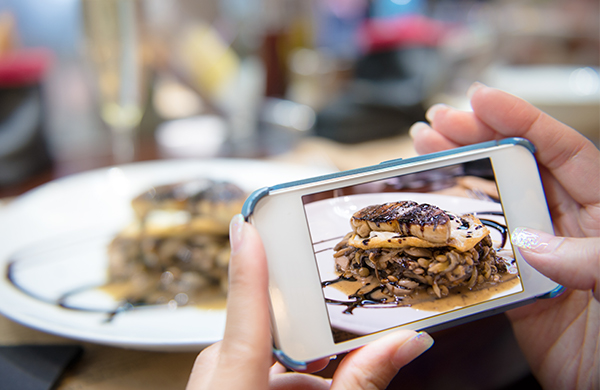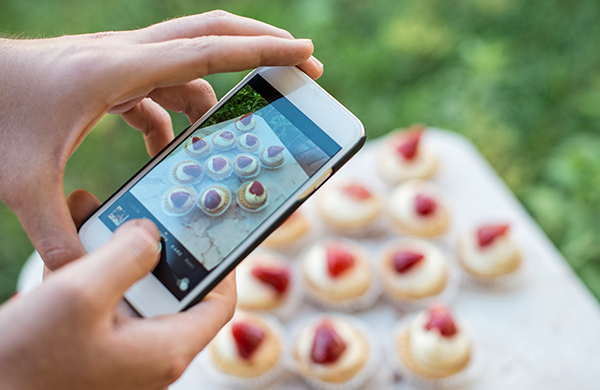
A dainty sweet-potato bourbon cake. A deconstructed cheesecake topped with a sphere of fruit purée. A crème brûlée decorated with delicate, edible flowers. Ceviche plated to look more like a frothy cocktail than a bite of raw fish. These are just a few of the dishes that Chef Roque Heidler has conceptualized, plated, and posted to Instagram over the years.
Jump to his five tips for food photography.
This Tulsa chef is a bit of a Renaissance man. First and foremost, he works at The Chalkboard, an elegant New American restaurant where he does triple-duty as chef de cuisine, pastry chef, and resident plating expert. There, he quickly earned a reputation for his immaculate desserts, which helped him win the Sweets category in the first annual Taste of Groupon Awards. But that’s just his day job.

Over the years, Chef Heidler’s explored all sorts of facets of the art world. He experimented with street art in his youth, and, early on in his career, he took a two-year hiatus from the food industry to work as a tattoo artist. Today, he’s using those art skills to create the stunning desserts that first caught our attention.
We had the chance to chat with Chef Heidler after he won his award recently. Here are some of the highlights from our conversation.
Turning dining into an adventure
For Chef Heidler, cooking is all about balancing the familiar and the surprising. “I generally like to do a take on my childhood favorites,” he explained. He starts with these classic dishes and infuses them with “some sort of whimsy” while maintaining their approachability.
Frequently, that whimsy he talks about comes in the form of some sort of sneaky molecular-gastronomy trick, be it dessert gels made with agar or fruit purées transformed into delicate spheres that crack open with the whack of a spoon. Or, consider his take on chocolate pie:
“I got ahold of some methylcellulose and I did this crazy, crazy mad-scientist chocolate pie … that had this strawberry-buttermilk foam and this methylcellulose chocolate filling. [The filling] would be liquid at 70 degrees, but once you heated it up to 140, it would turn into that custard state.” The resulting dessert balanced different temperatures, textures, and flavors—subverting the diners’ expectations about what a classic chocolate pie could be.
How his unique background inspires his food
An artistic eye pervades everything Roque Heidler does. Though it’s been years since he did any street art or worked in a tattoo parlor, those experiences still give him a unique outlook on food: “I’ll look at flavors sometimes as colors, if that makes any sense. And I plate them out like that. Sometimes I’ll base a whole dish on a color and search for those flavors that go with it,” he said.
But over the years, he’s learned to let the flavors shine as much as the aesthetics. “Like, I mean, if you dig back a little deeper in [my career] ... you’ll see more of that really, really modernistic art on the plate, and I’ve dialed back from that a lot. I kind of learned, you know, you’ve gotta plate to the crowd.”
Working under the constraints of a traditional Lebanese restaurant helped him strike the right balance even more. “I just would take their classic flavors and would try to just distribute it out in that street-art form, like, layers and different takes and elevating it with different textures. But working under that [chef] taught me a lot about not detracting from the flavors so much that you couldn’t tell where it was from.”
Plating food like a pro
Now that he’s traded in no-frills Lebanese cuisine for fine dining at The Chalkboard, Chef Heidler has a lot more room to experiment with his food’s presentation. But even though he knows that many of his diners will rush to snap and post photos of these beautiful plates, he tries not to let that Instagram culture shape what he does too much.
“I don’t think about 6 o’clock. I don’t think about any sort of clockwise on a plate. I more or less look for that overall balance from a bird’s eye view,” he said. That’s because when a plate is placed in front of a diner, that’s the first perspective they get. And this first impression is important—even if the guest immediately drops down to plate level to snap that perfect piece of food-porn photography.
They say that you eat with your eyes first, so moments like these are vital to a restaurant’s success. But last impressions are just as important as first ones at The Chalkboard. “I love doing the plate ups on desserts because it’s gonna be the last thing that sticks in your mind when you leave,” Chef Heidler said.

Five tips for improving your food photography
When his knack for plating, arts background, and love of Instagram, Chef Heidler is a force to be reckoned with when it comes to food photography. That’s why we took the opportunity to ask him for some of his best tips.

1. Find the best lighting.
Natural light is your friend.
2. Shoot on neutral backgrounds.
Chef Heidler works on gray tables at The Chalkboard, but he recommends photographing your own food on “anything black or white—that’s always going to give another element to your photo.”
3. Combine different textures.
Varying textures form the most interesting compositions. “Try to provide three different textures, be it a purée, be it a frozen element, be it something crunchy. ... That’s what’s going to give you that depth in your dish.”
4. Add some acid to boost the colors.
This is especially true if you’re photographing a dish you cooked yourself. “[Acid] will give you those bright, vibrant colors everybody tries to achieve,” he suggests. This usually means adding lemon juice or white vinegar to a dish to bring out its natural green, purples, or reds.
5. Try different angles.
He explains, “Take a step around, even if it’s like, I don’t know, 6 inches from where you were just at. You might capture a cooler way.”






